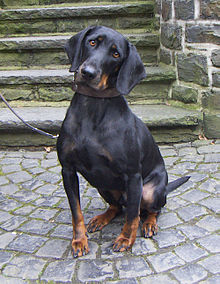The Austrian Black and Tan Hound is a medium sized scenthound originating in Austria and is used for tracking wounded game, most commonly hare, in high altitudes.
| Austrian Black and Tan Hound | |||||||||||||||||||||||
|---|---|---|---|---|---|---|---|---|---|---|---|---|---|---|---|---|---|---|---|---|---|---|---|
 | |||||||||||||||||||||||
| Other names | Brandlbracke Vieräugl Austrian smooth-coated hound Carinthian brandlbracke Österreichescher Glatthaariger Bracke Kärntener Hunde Österreichische Bracke | ||||||||||||||||||||||
| Common nicknames | Bracke (colloquially called Vieräugl) | ||||||||||||||||||||||
| Origin | Austria | ||||||||||||||||||||||
| |||||||||||||||||||||||
| |||||||||||||||||||||||
| Dog (domestic dog) | |||||||||||||||||||||||
History
editThe breed's history can be traced back to ancient times when the inhabitants of Austria selectively bred dogs for hunting purposes. The Austrian Black and Tan Hound's ancestors were likely a crossbreed of various Celtic hounds, possibly mixed with Jura hounds from Switzerland.[1][2]
During the 19th century, Austrians began to advocate for the development of breed standards and purebred registries for their hounds. In 1884, the Österreichischen Hundezuchtvereins (lit. Austrian dog breeding club) was founded and the first dog registered was an Austrian black and tan hound named "Bergmann."[3] The Federation Cynologique Internationale (FCI) recognized the breed in 1954 and the United Kennel Club in 2006.[4][5]
Description
editAppearance
editColouring in this breed is highly important. The dogs have a smooth, dense and short black coat with tan or fawn markings on the legs, chest and face. Two fawn marks above the eyes must be present. The long tail is slightly bent and the ears are medium in length and lie flat with rounded tips.[1] They are a medium sized breed, with a large skull and brown eyes.[6] Males are 50–56 centimetres (20–22 inches), while females are 48–54 centimetres (19–21 inches).[1] They weigh 15–22 kilograms (33–49 pounds).[7] The dark coat helps protect the dog from harsh weather conditions, while the tan markings make it easily visible to hunters in dense vegetation.
Temperament
editIt is an elegant runner, used in tracking all sorts of game. It has a lovely voice, and makes a great pet due to its affectionate and good-natured personality. It is not a dog wanting to be in a city. A suitable home will be in a rural area where the dog will have much space to run unrestricted by a leash. It loves to work.[7][8]
Uses
editThe Austrian black and tan hound has a keen sense of smell that is used to track wounded game, most commonly hare, in high altitudes.[7] Austrian black and tan hounds have been used in the detection of emerald ash borer.[9]
Health
editThere are no breed-specific genetic diseases known to affect this breed, which is fairly healthy, and lives up to 12 to 14 years of age.[7]
Etymology
editThe Austrian black and tan hound is known by a myriad of names including the Austrian smooth-coated hound, the Austrian or Carinthian brandlbracke or vieräugl, the Kärntener Hunde, Österreichische Bracke or the Österreichescher Glatthaariger Bracke.[2][1][10][8]Brandlbracke is a compound word, stemming from "Brand" (harmful fire, fire that went out of control) which refers to the fawn markings and "Bracke", a type of hunting dog that primarily tracks through scent.[11][citation needed] Vieräugl is the Austro-Bavarian diminutive of "Vierauge", meaning: somebody our something having four eyes. It refers to the distinctive fawn markings above the eyes.[citation needed]
See also
editReferences
edit- ^ a b c d "Austrian Black and Tan Hound Breed Standard" (PDF). Federation Cynologique International. Retrieved 29 November 2014.
- ^ a b Morris, Desmond (2002). Dogs: The Ultimate Dictionary of over 1,000 Breeds (Reprint ed.). Trafalgar Square Pub. pp. 95–96. ISBN 978-1-57076-219-2.
- ^ Thierrichter, Regina. "Leistungsorientierte Rassehundezucht am Beispiel zweier österreichischer Jagdhunderassen Brandlbracke-Steirische Rauhaarbracke" [Performance-oriented purebred dog breeding Example of two Austrian Hunting dog breeds Brandlbracke-Styrian Wire-haired Bracke] (PDF). Universität für Bodenkultur Wien: 17.
- ^ "BRANDLBRACKE - (VIERÄUGL)". www.fci.be. Retrieved 2024-01-20.
- ^ "AUSTRIAN BLACK AND TAN HOUND" (PDF). United Kennel Club. 2006.
- ^ Mason, Walter Esplin (1915). Dogs of all nations. University of California Libraries. University of California Libraries. p. 81.
- ^ a b c d "Hunderasse Brandlbracke (Auch Österreichische glatthaarige Bracke) - Snautz.de". Archived from the original on 2012-09-03. Retrieved 2012-08-19.
- ^ a b Pugnetti, Gino; Schuler, Elizabeth Meriwether (1980). Simon & Schuster's guide to dogs. New York: Simon and Schuster. p. 146. ISBN 978-0-671-25526-8.
- ^ Hoyer-Tomiczek, Ute; Hoch, Gernot (2020-03-05). "Progress in the use of detection dogs for emerald ash borer monitoring". Forestry: An International Journal of Forest Research. 93 (2): 326–330. doi:10.1093/forestry/cpaa001 – via Oxford Academic.
- ^ Huber, Thomas (2009). "Der Einsatz von Stöberhunden bei der Rot- und Rehwildjagd" [The use of hunting dogs in red and roe deer hunting]. Bericht über die 15. Österreichische Jägertagung 2009 zum Thema Hund & Co Tierische Helfer bei der Jagd [Report about the 15th Austrian Hunter Conference 2009 on the subject Dog & Co Animal helpers in hunting] (PDF) (in German). LFZ Raumberg-Gumpenstein. p. 38.
- ^ Recum, Andreas F. von (2002-11-30). Hunting With Hounds in North America. Pelican Publishing. p. 15. ISBN 978-1-4556-0614-6.